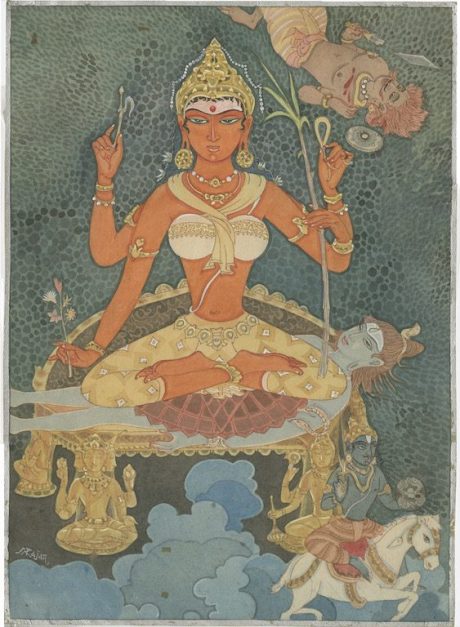Some scholars state that there is no mention of Shakti in the Yoga Sutras. This is incorrect. Shakti is the last word in the Yoga Sutras that sums up its entire teaching and defines its ultimate goal as the realization of the Purusha. It suggests what is referred to as Kundalini Shakti in other Yoga texts.
The Yoga Sutras ends (YS IV.34) with a description of Kaivalya, the highest Samadhi and the state of the Purusha that is the goal of Yoga practice, in the following words:
“The subsidence of the gunas when the Purusha has no interest in them is Kaivalya (liberation), or when there is the resting in the Self-nature of the Shakti or power of Consciousness (Kaivalyam Svarūpa pratiṣṭhā vā Citi Śaktir iti).”
The last term in the Yoga Sutras here is Chiti Shakti or power of consciousness, as resting in its Self-nature which is the Self-nature of all. That is Kaivalya or liberation, the Self-realization of abiding as Purusha/Atman. This Chiti Shakti is also the Purusha Shakti or Atma Shakti, the knowledge power of the higher Self.
This Chiti Shakti echoes the Chit Shakti or power of Consciousness in Shaivite and Shakta philosophy, whose manifestation in the individual is Kundalini Shakti, which unfolds the process of Self-realization in its ascending movement from the root chakra below to the top of the thousand petal lotus of the head.
This last verse of the Yoga Sutras reflects in meaning the third verse of the text (YS I.3) that explains Yoga as resulting in “Abidance in the Self-nature of the Seer (Tadā Draṣṭuḥ Svarūpe avasthānam) or Purusha, which results from the Chitta Vritti Nirodha, the definition of Yoga as the detachment from, calming and disidentification with the mind or chitta (YS I.2).
Equating these two verses at the start and end of the text, we see that the Purusha or Seer (Drashta) and the Shakti of consciousness (Chiti-shakti) are united in the same Self-nature. Purusha/Atman and its Shakti or power of seeing and knowing are one, like Shiva and Shakti.
Patanjali and the Serpent Power
The name Patanjali refers to a type of serpent and he is portrayed in iconography as with serpent heads or serpents behind him. In this regard, Patanjali is identified with Ananta, the cosmic serpent on which Bhagavan Vishnu sits during the Pralaya, when the universal manifestation is withdrawn. It suggests Shiva Mahadeva, who is the lord of serpents and Adi Yogi or the primal guru of Yoga. This means that Patanjali appears as another manifestation of the Serpent Power like Kundalini which is called the Serpent Power. In the context of Yoga, serpents symbolize high powerful electrical forces of Consciousness and its Shakti, which have a knowledge power far beyond the energetic capacities of the mind.
Patanjali, Mantra and Vak Shakti
Patanjali, besides being a Yoga Seer, was famous as a grammarian who commented on the great Panini who hd codified classical Sanskrit. Such Sanskrit gramaer was not just an academic pursuit but a profound meditative study on how all sounds manifest from OM or Pranava, the primordial cosmic sound, a path of Mantra Yoga. As such, Patanjali was well acquainted with mantra and Vak Shakti, the power of speech that has always been associated with Chit-Shakti and Kundalini Shakti. These Sanskrit sounds are not just words but reflect the vibratory powers behind the universe as a whole.
Patanjali Yoga Sutras (YS I.26) refers to Ishvara as the eternal Guru of Yoga, not limited by time, whose indicator (vacaka) is Pranava/OM (YS nI27). This means that Mantra Yoga, which arises from OM, is the basis of Patanjali’s Raja Yoga and of Ishvara Pranidhana, surrendering to Ishvara, which is mentioned as one of the main means of gaining Samadhi, one of the three principles of Kriya Yoga and one of the five Niyamas.
Mantra Yoga unfolds its power in the individual through Kundalini Shakti, which has three and a half coils like Om, and consists of the letters of the Sanskrit alphabet that correspond to the petals of the six chakras of the subtle body. At a cosmic level, Vak Shakti is Ishvara Shakti, the power of Ishvara that is one with Ishvara, as Adi Yogi and Yoga Shakti. When her mantric power is awakened within us through her manifestation as the Kundalini, She takes us back to the state of Ishvara and our own inmost Self.
Such diverse correlations clearly show the profound connections that exist between Yoga Sutras and Shakti practices. While many other such correlations are also possible, what Patanjali taught about Yoga and the teachings of the Shakta tradition cannot be separated. Shakti is an integral part of the Yoga Sutras in its views of Pranava, mantra, Consciousness and perception. Shakti texts teach an integral Raja Yoga, much like the Yoga Sutras, with practices of all eight limbs of Yoga, as well as an emphasis on Shiva and Shakti.
Honoring the place of Shakti in Yoga is the very essence of Yoga. Without this Yoga Shakti or power of consciousness, the inner Yoga of Self-realization cannot succeed. Do not leave the Shakti out of your Yoga practice or out of your study of the Yoga Sutras.
David Frawley (Vamadeva Shastri)







